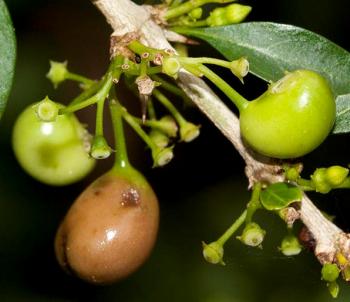Canthium spinosum
Canthium spinosum (Klotzsch ex Eckl. & Zeyh.) Kuntze
Family: Rubiaceae
Common names: thorny turkey-berry, coastal turkey-berry, coastal canthium, thorny rock-alder (Eng.); doringklipels, doringbokdrol (Afr.); ubuchopho benja, isiphambatho (Xho.); umcenyane, umphembethu, umvuthwamini-omncane (Zul.)
SA Tree No: 707
Introduction
A shrub or small tree with spiny branches, pale grey bark and edible berries that are also popular with birds. It makes an excellent hedge, and the wood is yellow, fine grained and heavy.

Description
Description
A large multi-stemmed shrub or small to medium-sized evergreen tree, 4-5 m up to 10 m high. Main stem erect with rigid branching. Bark pale grey.

Spines at each node, in pairs at right angles to the stem, straight, woody, up to 25 mm long. Leaves in clusters on dwarf side shoots below spines, or opposite on young stems, small, 15–50 × 7–25 mm, but usually 30–50 × 15–25 mm, softly hairy when young, becoming hairless, olive-green, paler green below, 2–5 pairs of lateral veins, with small domatia; apex broadly tapering, base tapering; petiole 1–2 mm long; stipules triangular with long point, falling early.

Flowers greenish white, scented, about 5 mm in diameter, inconspicuous, in short branched heads, 10–20 mm in diameter, on dwarf spur-branchlets, from midwinter to midsummer (July–December).

Fruit ovoid, about 13 × 10 mm, blue-black, sometimes 1-lobed and asymmetric, or shallowly 2-lobed, bluish grey when ripe, edible and pleasantly flavoured; 1–2 seeds in spring and summer (September–January).

Conservation Status
Status
This taxon was not selected in any one of four screening processes for highlighting potential taxa of conservation concern for detailed assessment and was hence given an automated status of Least Concern (LC ). The Threatened Species Programme is currently systematically completing full assessments for all taxa with an automated status.
Distribution and habitat
Distribution description
The plant occurs in coastal forest and bush, along forest edges, often on rocky hill slopes, and in bush clumps in grassland, from about the Uitenhage and Bathurst Districts in the Eastern Cape, northwards through the former Transkei into KwaZulu-Natal.
Derivation of name and historical aspects
History
Canthium was named by Jean-Baptiste Lamarck in 1785 in Encyclopédie méthodique. The name is a Latinisation of kantankara, a Malayalam name from Kerala for Canthium coromandelicum. Kantan means ‘shining’ and kara means ‘a spiny shrub’. The specific name is based on the Latin spinosus, meaning ‘spiny’.
This species was first named by Klotzch as Plectronia spinosa and then renamed Canthium spinosum by Kuntze.

Ecology
Ecology
The flowers are visited by solitary bees, wasps and flies. The fruits are eaten, and seeds dispersed, by monkeys and birds. Since the seeds are dispersed by birds, take note that this plant will seed itself freely in the garden and surrounds, and thus could become invasive. Birds use these plants as nesting sites.

Uses
Use
Fruits are edible and palatable, taste a little like dried peach, and are eaten by people. The wood is yellow, fine-grained and heavy. This plant is used in traditional medicine, probably in the same was as Canthium inerme, to treat stomach complaints, dysentery and diarrhoea.
Growing Canthium spinosum
Grow
Canthium spinosum is easily propagated by seed. Collect fruits when ripe, and clean off the flesh prior to sowing. Sow seed in spring or early summer, well-drained sowing medium and place in a warm, brightly lit place and keep moist but not wet. Seed germinates in about 2-3 weeks. Allow germinated seedlings a few months of growth and transplant them into pots or bags when the first 4 true leaves have appeared. Plant in fertile, well-composted soil, well-drained soil, feed with liquid fertiliser at the rate recommended by the product, and water well until established.
The plant is suitable for sun, semi-shade or shade, but it will flower and fruit better in a sunny position. It makes an excellent hedge that can be trimmed to shape, and its spines make it an effective barrier plant. Trimming increases the number of stems, which are full of spines that remain on the plant for years. It is best grown in frost free regions and along the coast.
References
- Coates Palgrave, K. 2013. Trees of southern Africa, Edn 2. Struik Publishers: Cape Town.
- Hutchings, A., Scott, A.H., Lewis, G. & Cunningham, A.B. 1996. Zulu medicinal plants: an inventory. University of Natal Press, Pietermaritzburg.
- Palmer, E. & Pitman, N. 1972. Trees of southern Africa. Balkema, Cape Town.
- Pooley, E. 2003. The complete field guide to trees of Natal, Zululand and Transkei. Natal Flora Publications Trust, Durban
Credits
Cathbert Makgakga
National Herbarium, Pretoria
And Geoff Nichols
Freelance Horticulturist
July 2018
Plant Attributes:
Plant Type: Shrub, Tree
SA Distribution: Eastern Cape, KwaZulu-Natal
Soil type: Sandy, Loam
Flowering season: Spring, Early Summer, Winter
PH: Acid, Neutral
Flower colour: Green, White, Cream
Aspect: Full Sun, Shade, Morning Sun (Semi Shade), Afternoon Sun (Semi Shade)
Gardening skill: Easy
Special Features:
Horticultural zones









Rate this article
Article well written and informative
Rate this plant
Is this an interesting plant?
Login to add your Comment
Back to topNot registered yet? Click here to register.